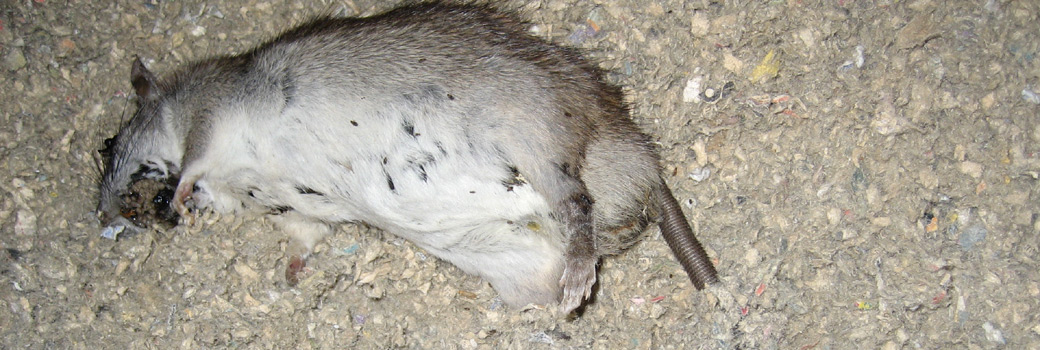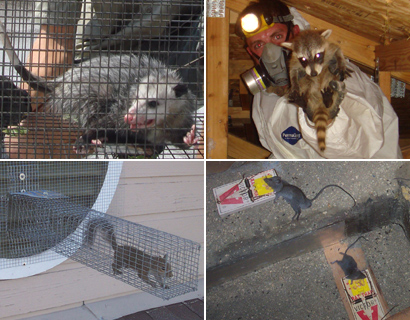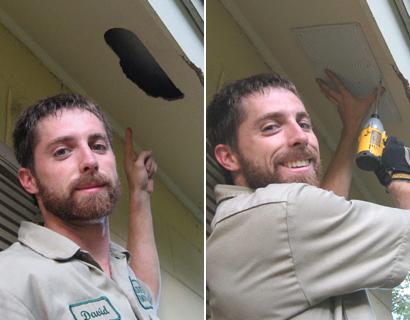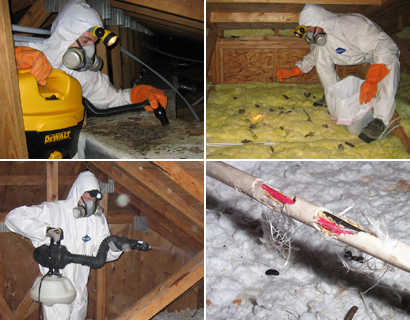- How We Solve Virginia Wildlife Problems
How We Solve Hampton Roads Wildlife Problems
INSPECTION: Once on site, we will perform a full inspection of your home and property. This allows us to use the correct strategy and traps. If the animals are in an attic, a full building inspection is crucial, including the following:
- All ground-level areas, such as piper or A/C line entry & exit areas, A/C chase bottoms, ground-level vents, etc.
- All mid-level areas, such as dryer vents, siding gaps, first floor eaves or dormers, etc.
- We inspect the entire roof, including all plumbing stacks, ridge caps, vents, and other potential gaps or holes.
- We also inspect inside your attic, to identify animals and damage they have caused.
- If the animals are outside, we notice many subtle clues that will assist us in a successful strategy.
TRAPPING, EXCLUSION, REMOVAL: Once we understand what animal species we are dealing with, and the problem, we use the most effective means of removing the animals. We use dozens of different types of traps.
- Trapping - If trapping the animal(s) in live cage traps, trap type, set, and location are crucial to success.
- Exclusion - Oftentimes, we are able to simply set one-way doors or other exclusion devices that allow the animals inside a building to safely exit, but never get back inside.
- Removal By Hand - Sometimes we actually remove animals by hand, or with special tools like snare poles.
- The Law - In all cases, we obey state and local laws regarding wildlife, but aim to take the most humane approach.
ENTRY HOLE REPAIRS: Repairs are a crucial step in the wildlife removal process. In many cases, such as bat or rodent control, the job cannot be performed without detailed repairs, and in all cases, sealing the entry holes shut ensures that no future wildlife will ever enter your home.
- 100% of the entry holes must be found, and sealed shut, or the job is not complete.
- Our repairs are professional contractor grade, look good, and when applicable we use steel, which rodents such as rats or squirrels are unable to chew through.
- We give a written guarantee on our repairs against any future animal entry.
ATTIC DECONTAMINATION SERVICES: It may be desirable to clean your attic after we've removed the animals. They can leave behind large amounts of droppings, urine, hair, oils, food, nesting material, and so on. These remnants can attract insects like cockroaches, and the scent left behind can encourage new animals to chew their way into your house. You might experience odor problems from the waste. It's possible that mold will grow on waste areas.
- We remove or vacuum all droppings, or remove all the soiled insulation.
- We fog the attic with a special enzyme-based cleaner that destroys any organic matter and deodorizes the space.
- We repair damage, such as ductwork, electrical wires, pipes, insulation, and more.
Nuisance wildlife can be such a headache! Once you know they have made their way into your home, they can cause some serious problems. Some of them come into your homes to nest, or to avoid bad weather. Others are scavanging for food and may have gotten stuck. The last thing you want is for an animal to get stuck somewhere in your house and die, the smell the critter will emit is extremely foul. Our team specializes in finding your nuisance wildlife problem and removing them from your home. We also do everthing we can to keep them from coming back! We service the following cities: Aberdeen Gardens, Buckroe Beach, Farmington, Fox Hill, Hampton Woods, Northampton, Newmarket, Wythe, Phoebus, Chesapeake, Hampton, Newport News, Norfolk, Poquoson, Portsmouth, Suffolk, Virginia Beach, and Williamsburg. We also service the following counties: York County, Poquoson County, Norfolk County, Newport News County, Portsmouth County, and Northampton County.
Other Hampton Roads animal pest control topics:
How to Get Rid of Pigeons
How to Kill a Snake
Info About Flying Squirrels
How to Remove Wildlife From a Chimney
To learn more about our services, visit the Hampton Roads wildlife control home page.
This month's wildlife how-to article: How To Find And Remove A Dead Animal From Your House
How To Find And Remove A Dead Animal From Your House
It is natural that animals will die. What causes a problem for us is when a wild animal dies on our property. Most of the times we may not have known about the presence of the animal until it dies and the stench of its decaying body fills the house or the property. You may also end up noticing swarms of flies in the area where the dead animal is lying. It must be removed from the property immediately to avoid health risks and the unwanted odor. This is how you can find and remove the dead animal:

1. Try to narrow down the place where the dead carcass is by following the odor. You may need time to figure out where the animal died because sometimes, the odors may be strong in an area because of less airflow although the animal’s carcass is somewhere else.
2. If you live in an elevated house, then possibilities are that an animal may have died underneath. Crawl there to ensure that it is not the case.
3. Attics are another place that animals like. This means the dead carcass may be in the attic. Look around carefully and check the insulation too for signs of an animal.
4. If the animal ended up dying in the wall then you may have to sniff the wall till you find the place where the stench is unbearable. The dead animal may be present there. Use a drywall saw to cut open the wall.
5. Once you have located the carcass, use rubber gloves and a plastic bag to remove it from your home.
6. Spray the entire area with an enzyme based cleaner and make sure that you remove all maggots from the place too.
7. While squirrels, rats and mice can go in the trash can, if you have a bigger animal, then incinerating the animal is the best way to get rid of its carcass.
When you are handling a dead carcass, one of the most important things to remember is hygiene so that you do not run into any kind of health risk. The least you can do is use rubber gloves, but a facial mask is also very helpful. Always remember to keep an alcohol gel ready so that you can instantly remove any blood or fluid that may come in contact with your skin. Remember to take a bath after removing the dead animal and wash the clothes to avoid any parasites infesting your home.





